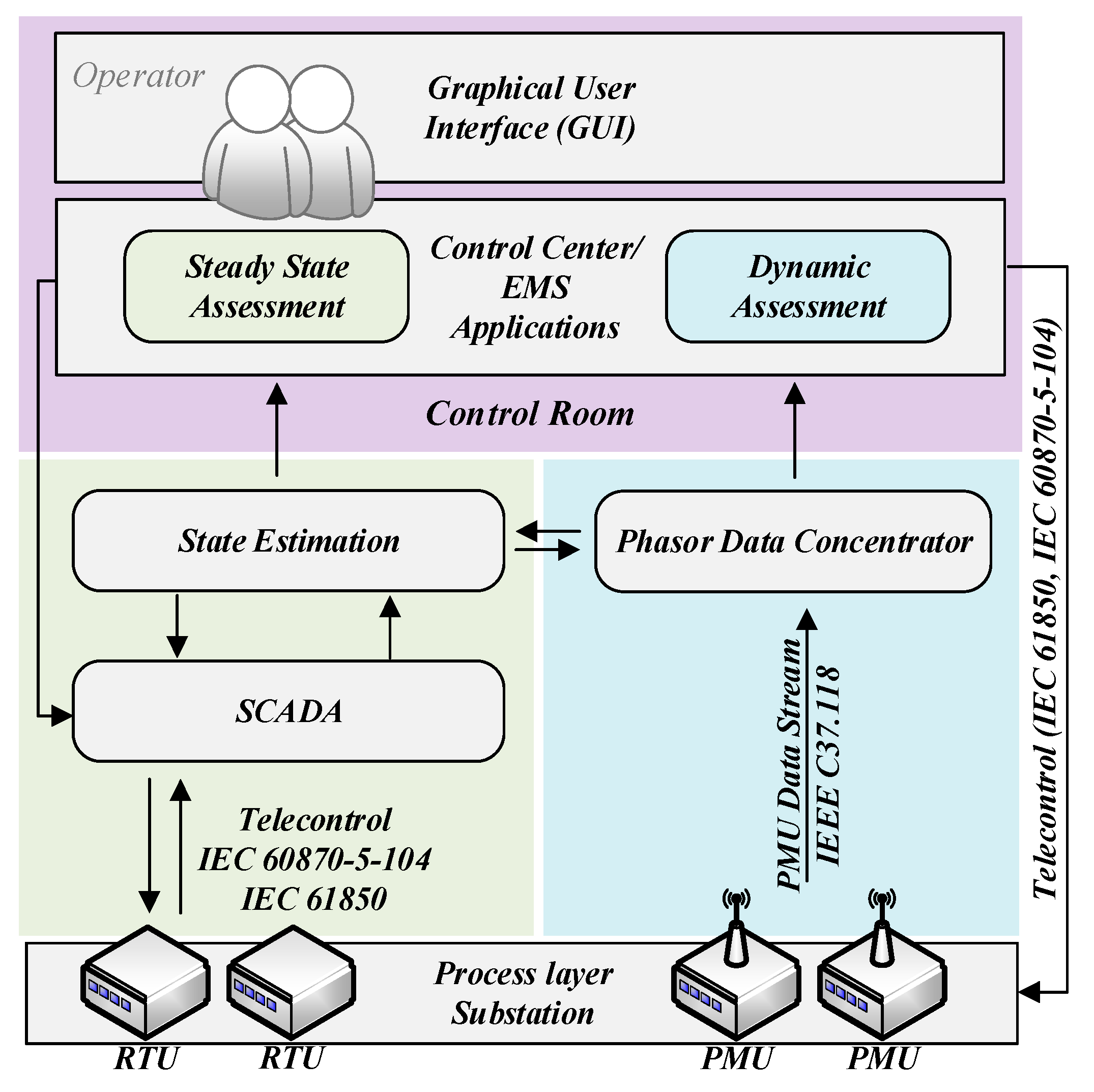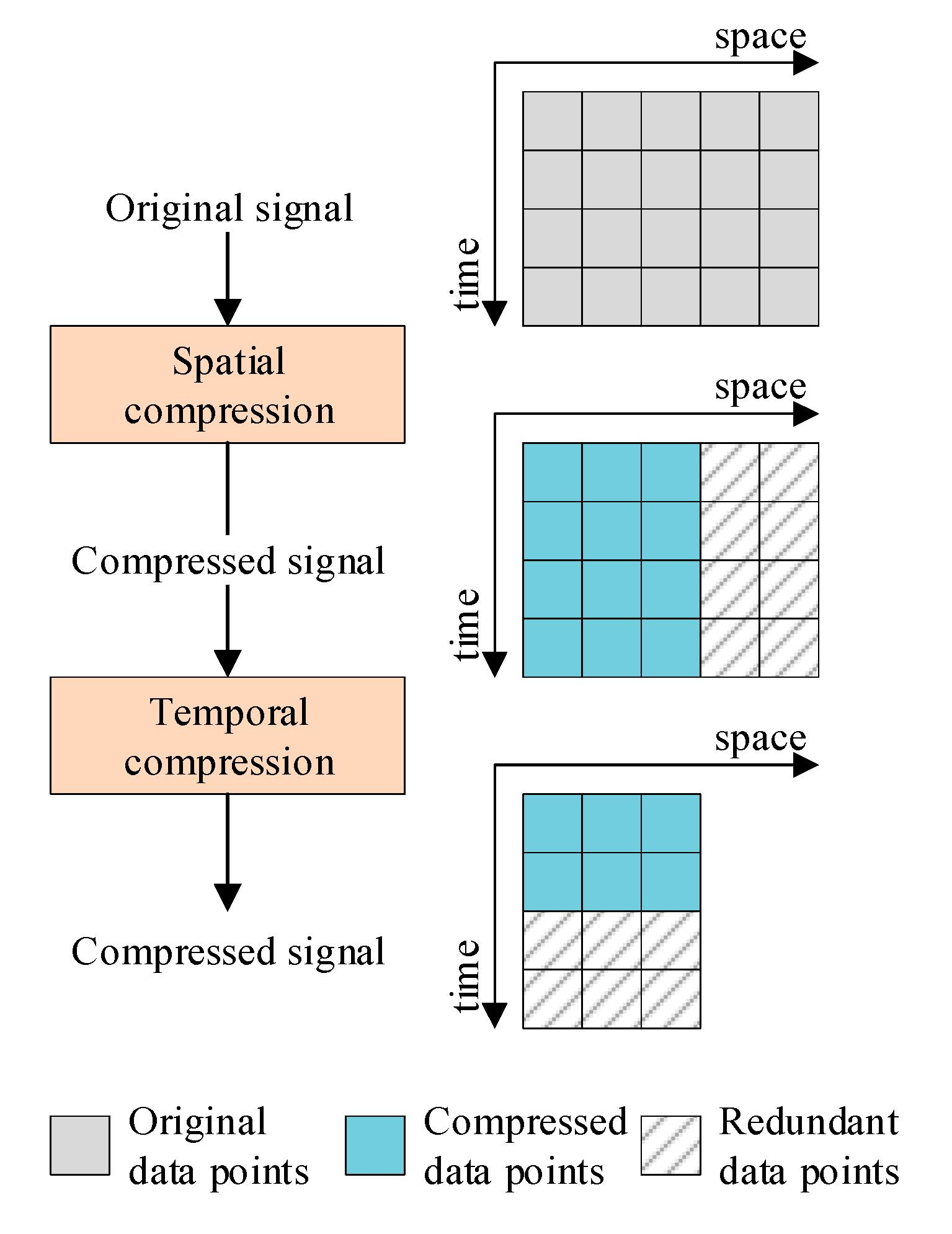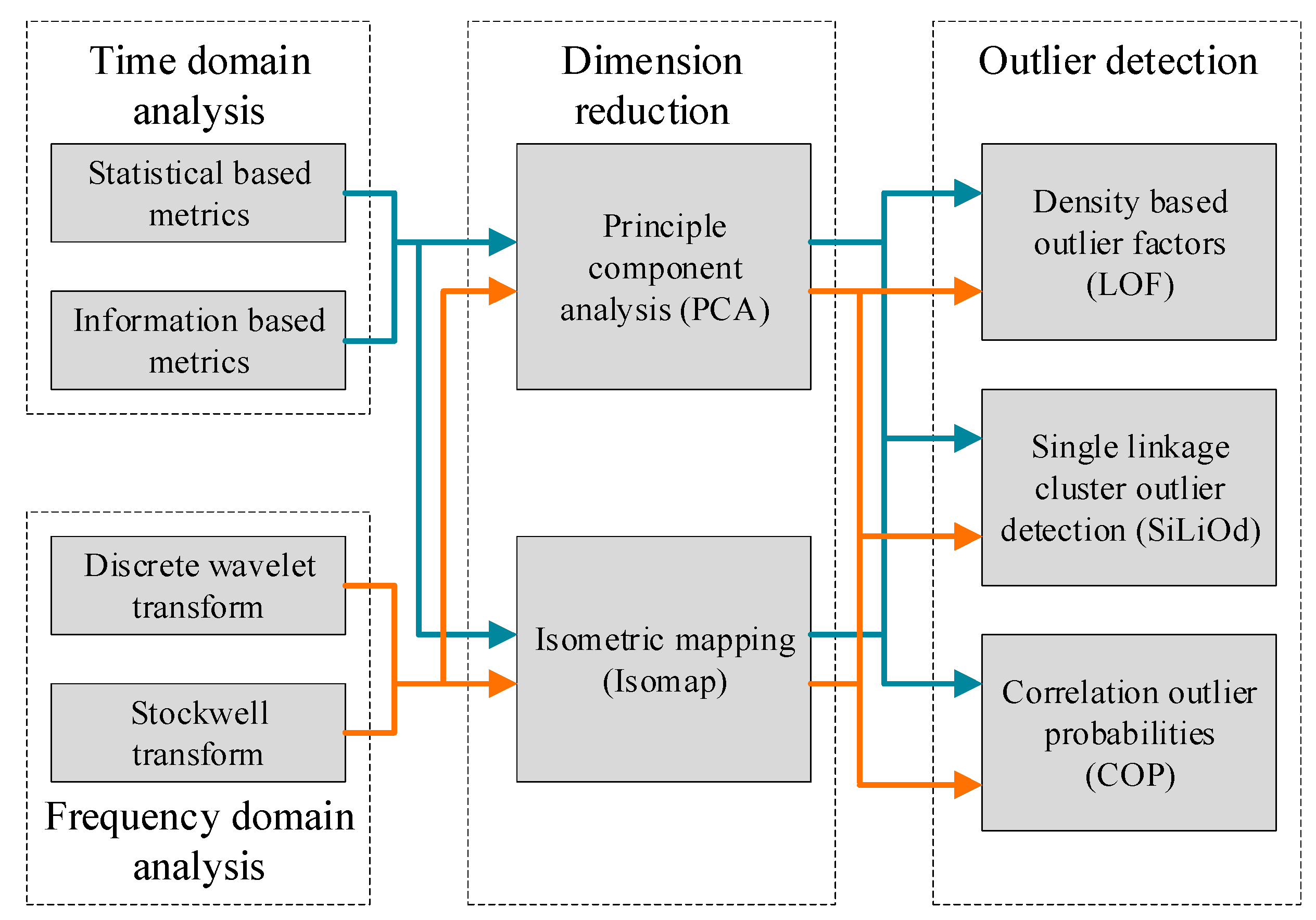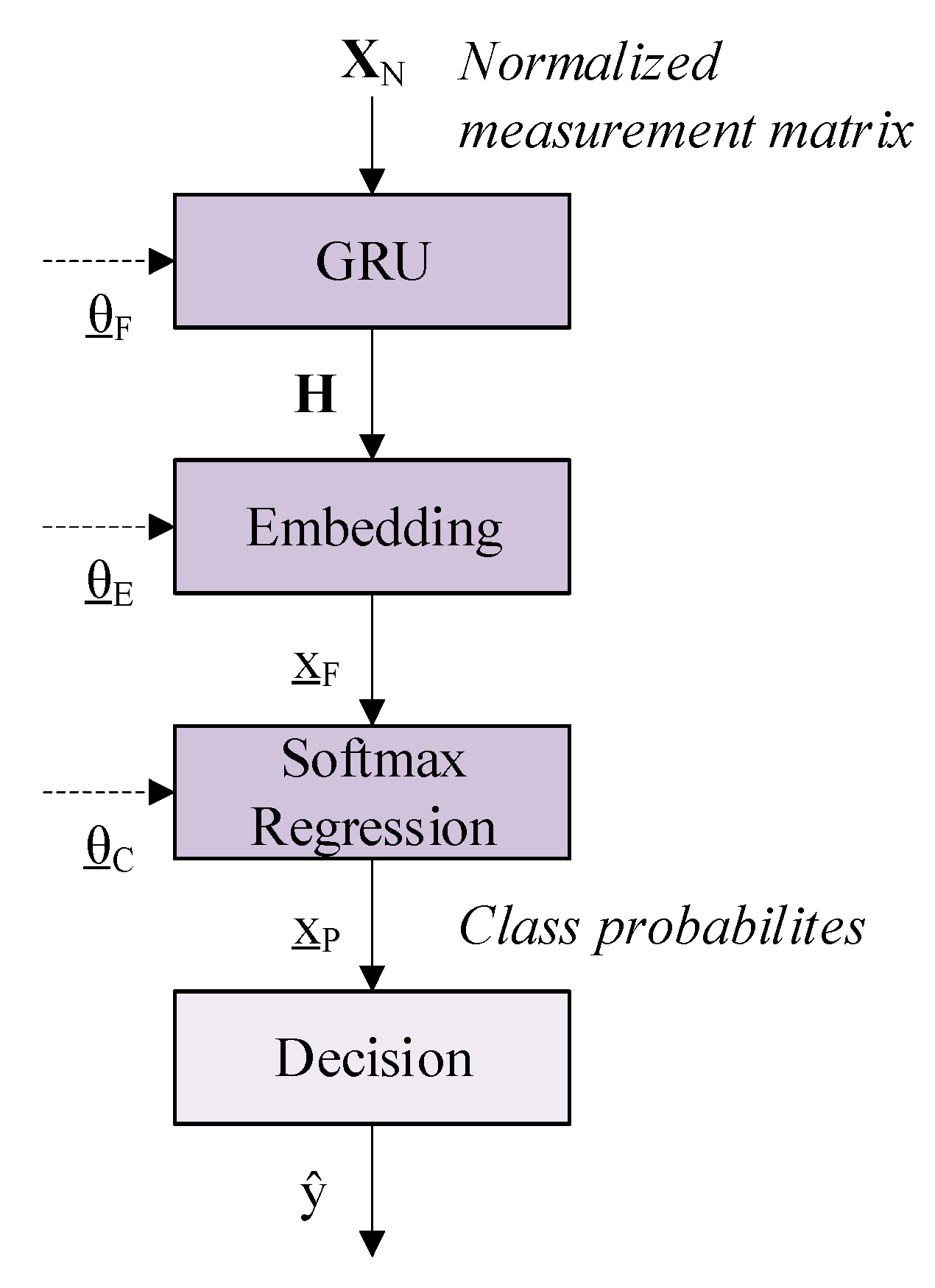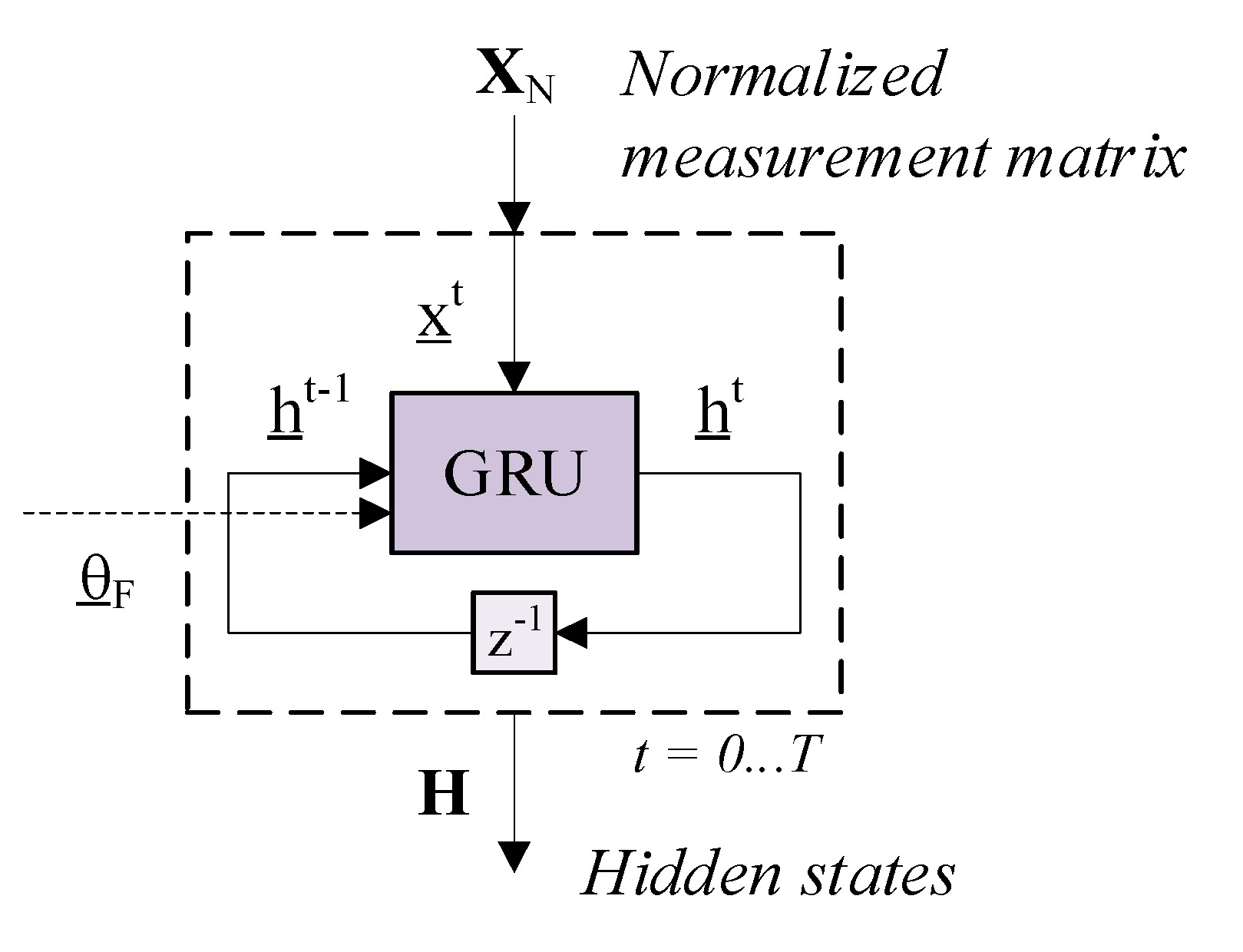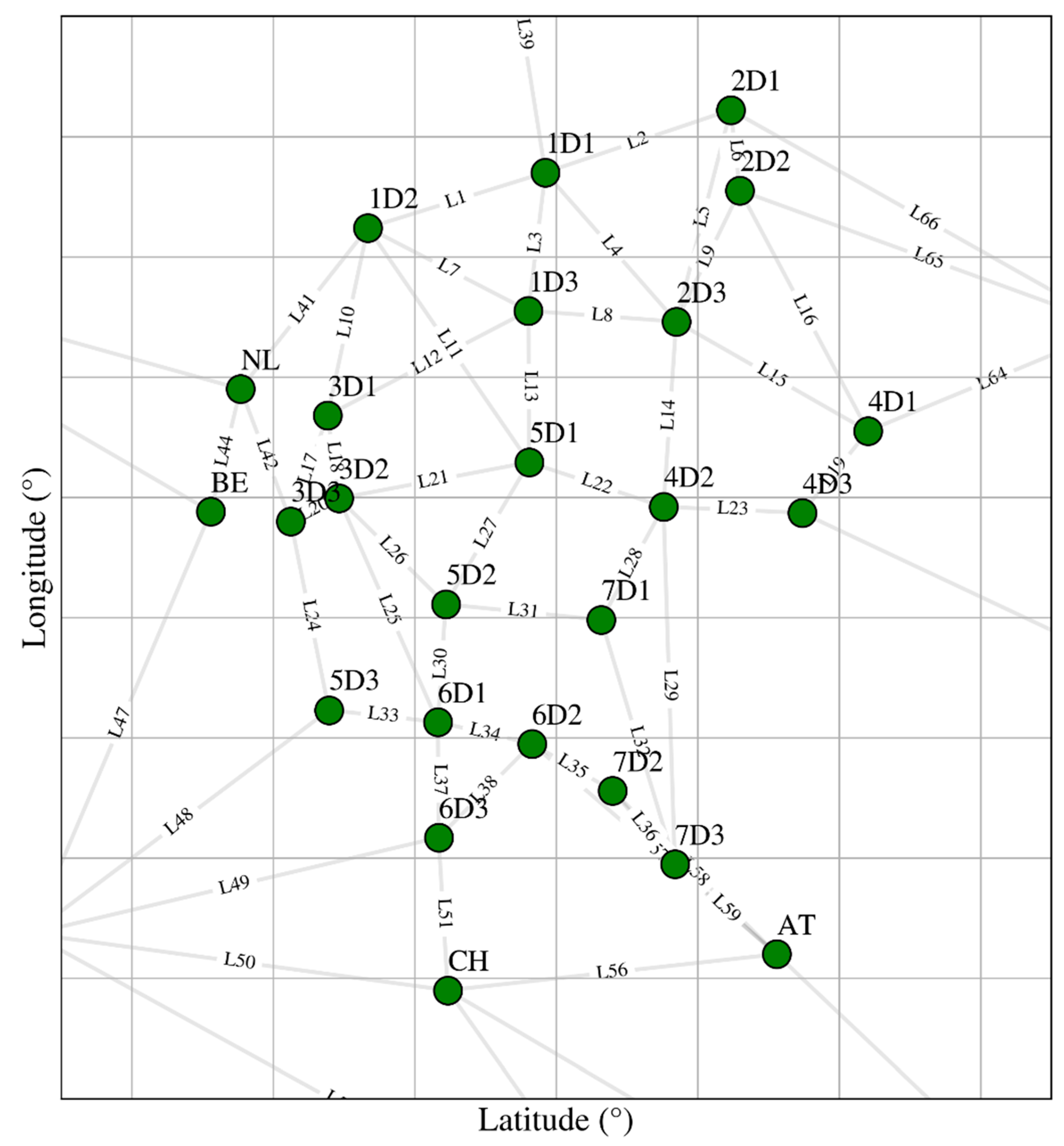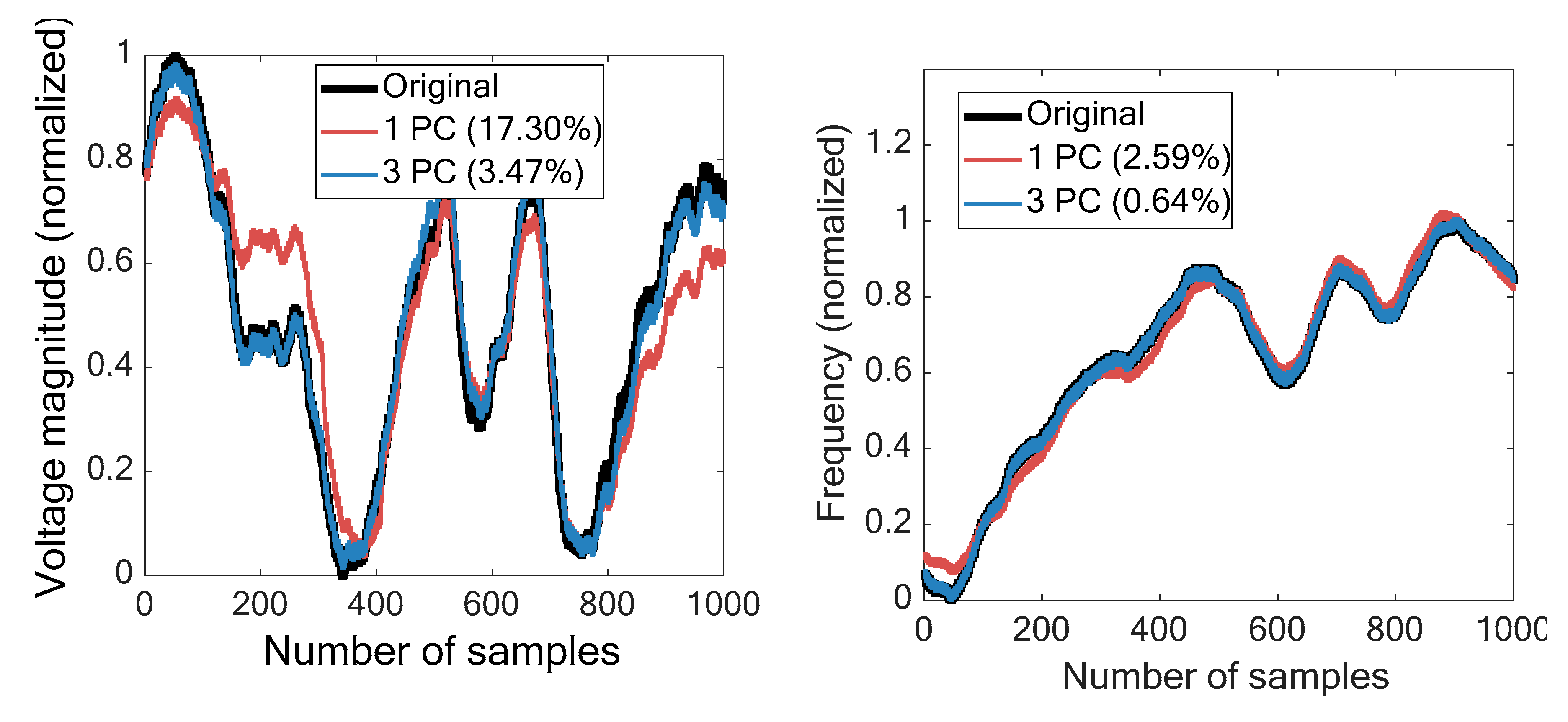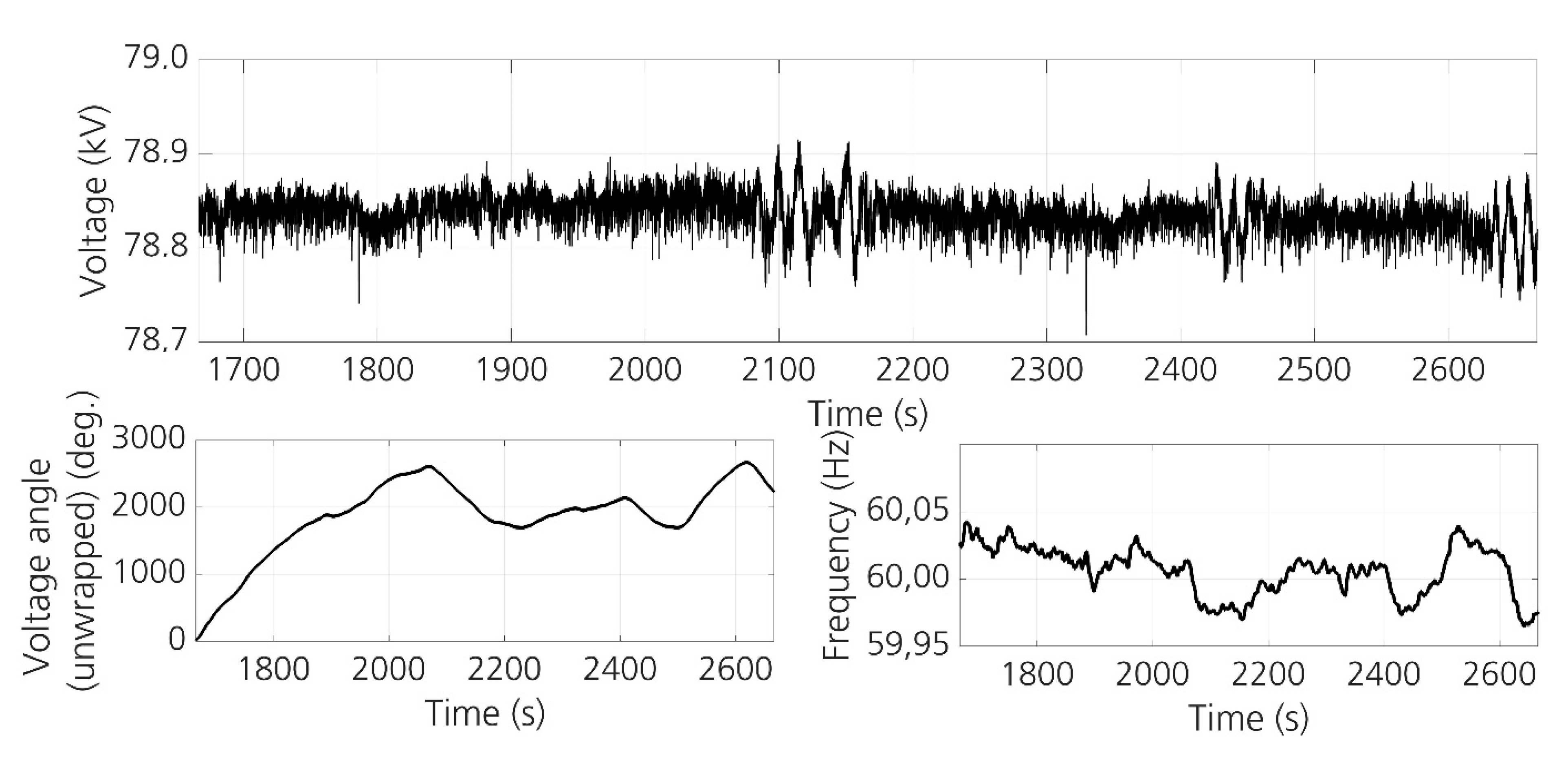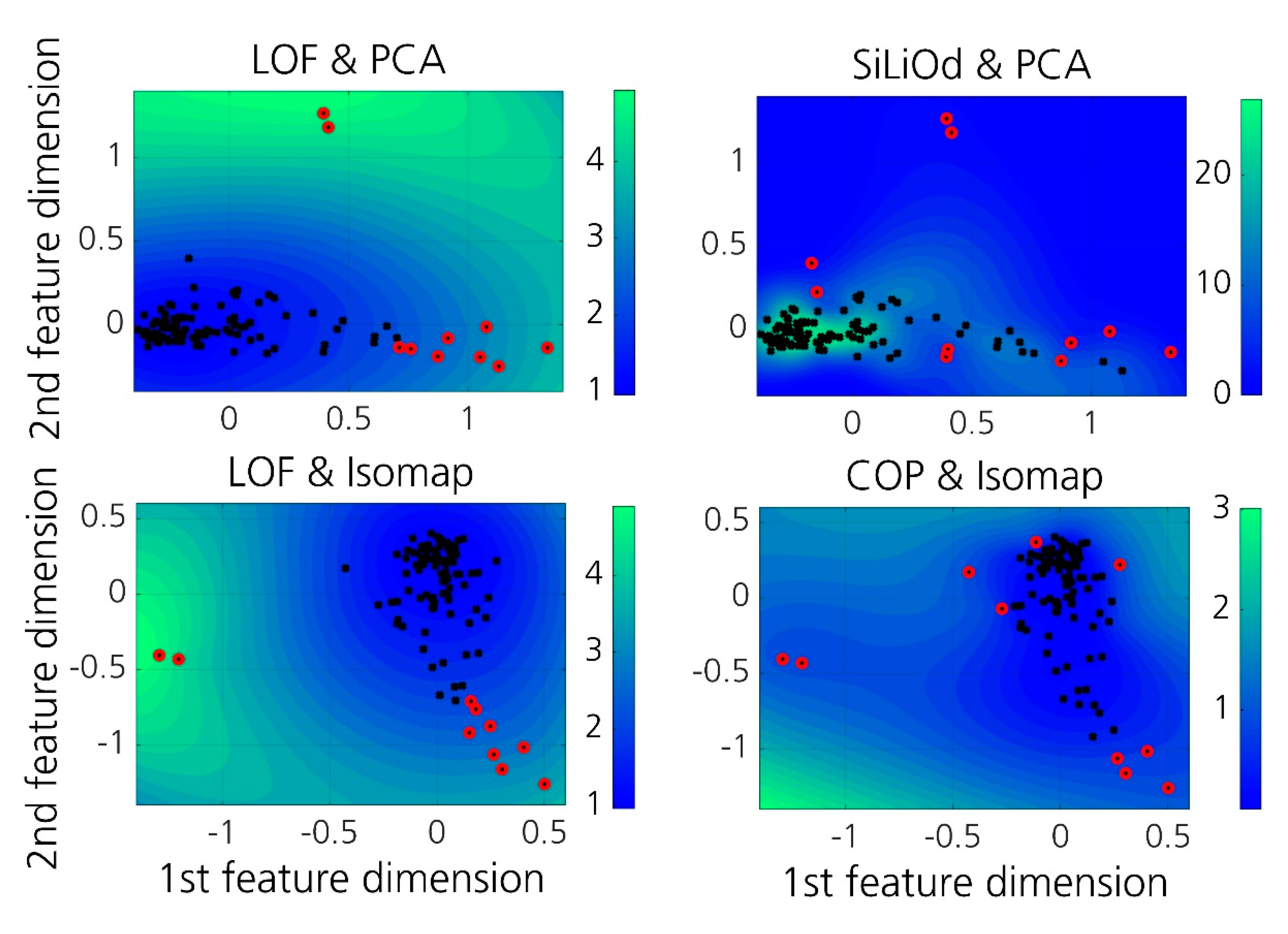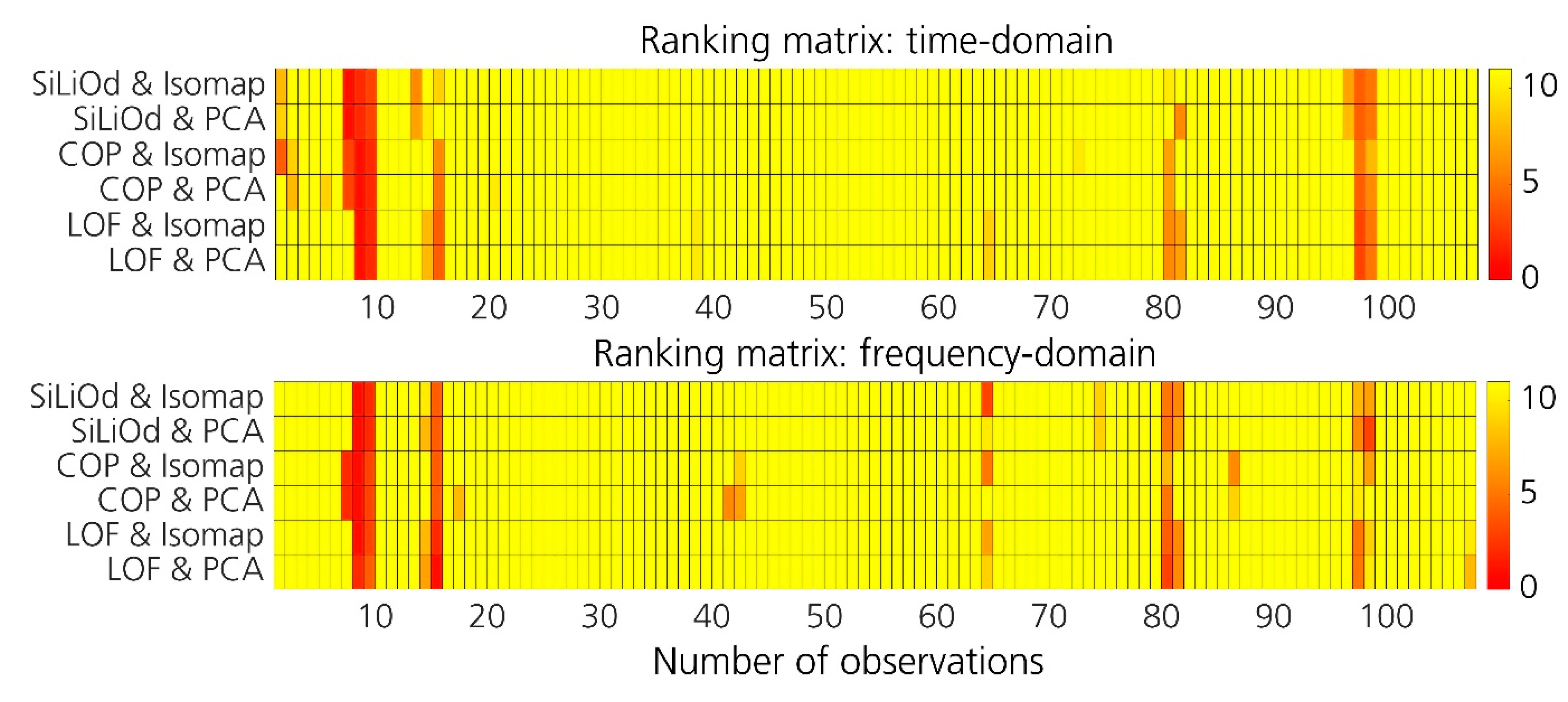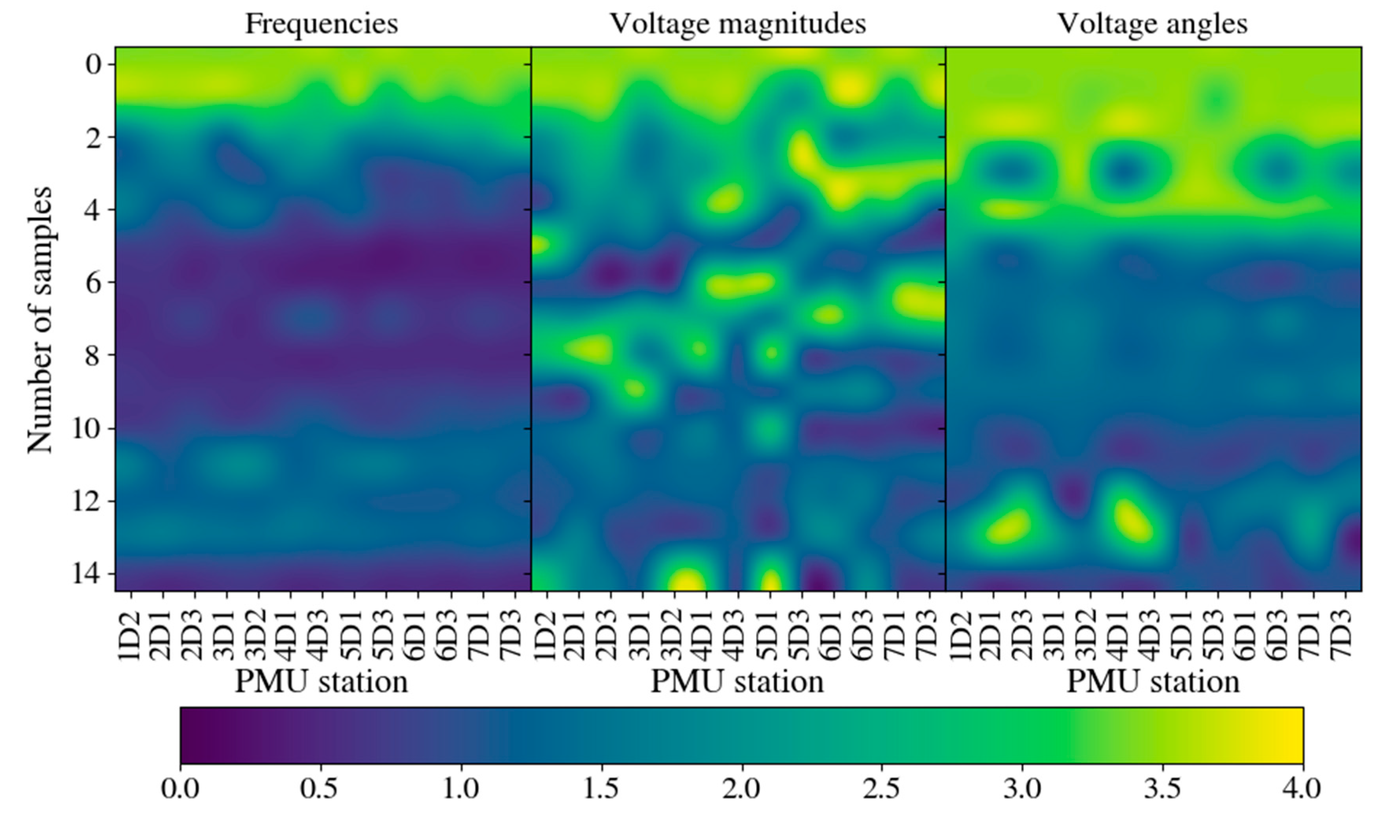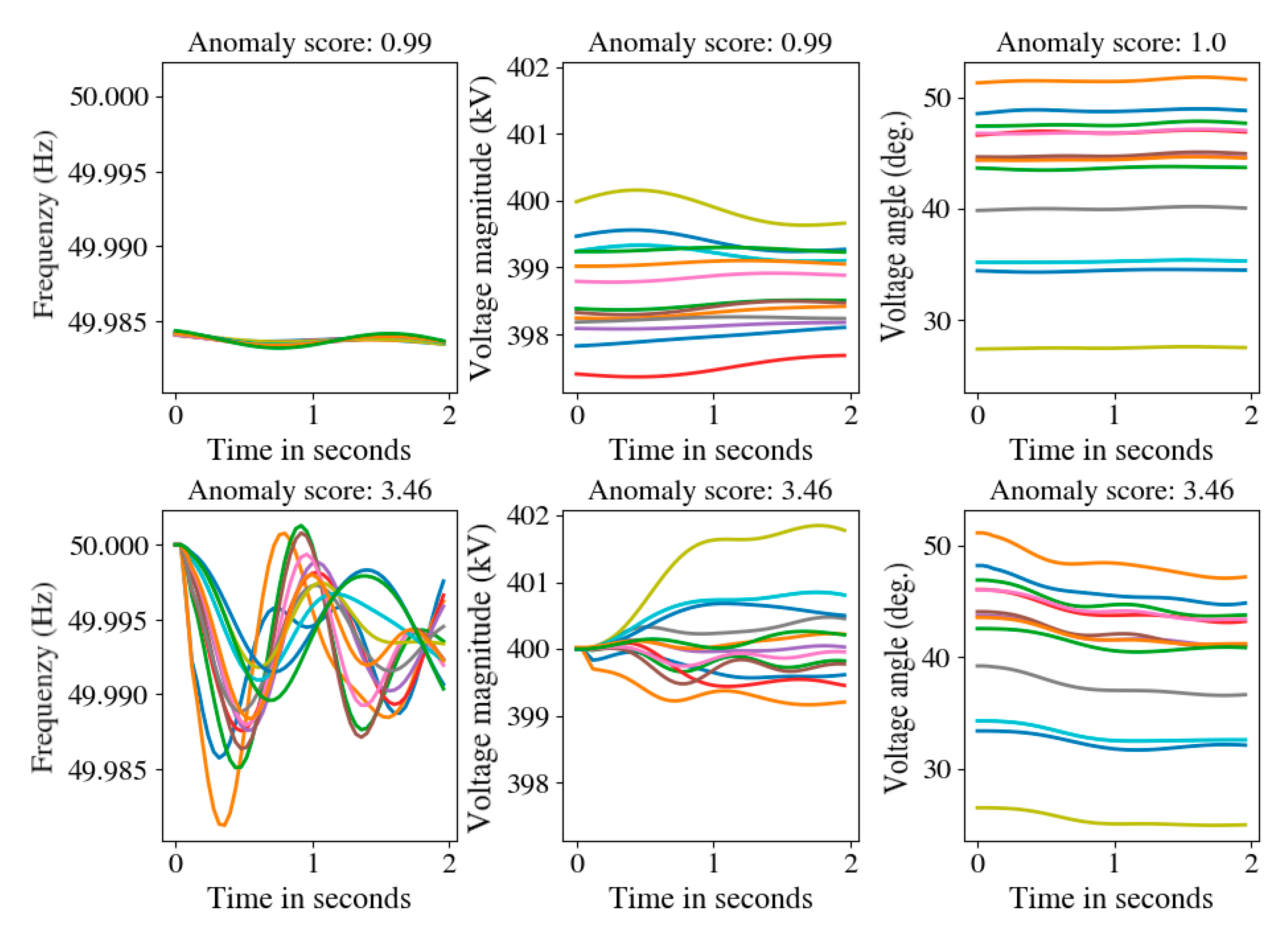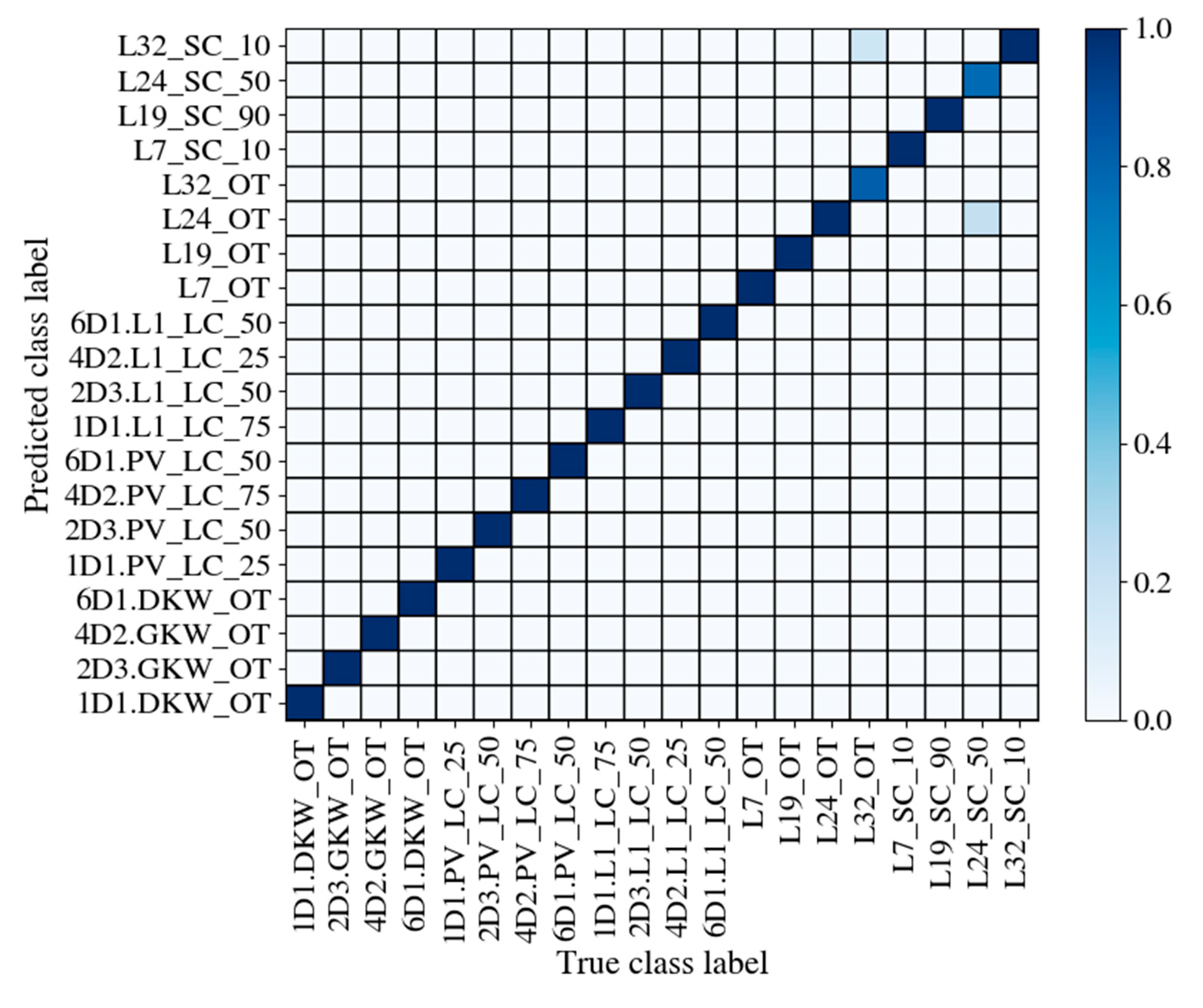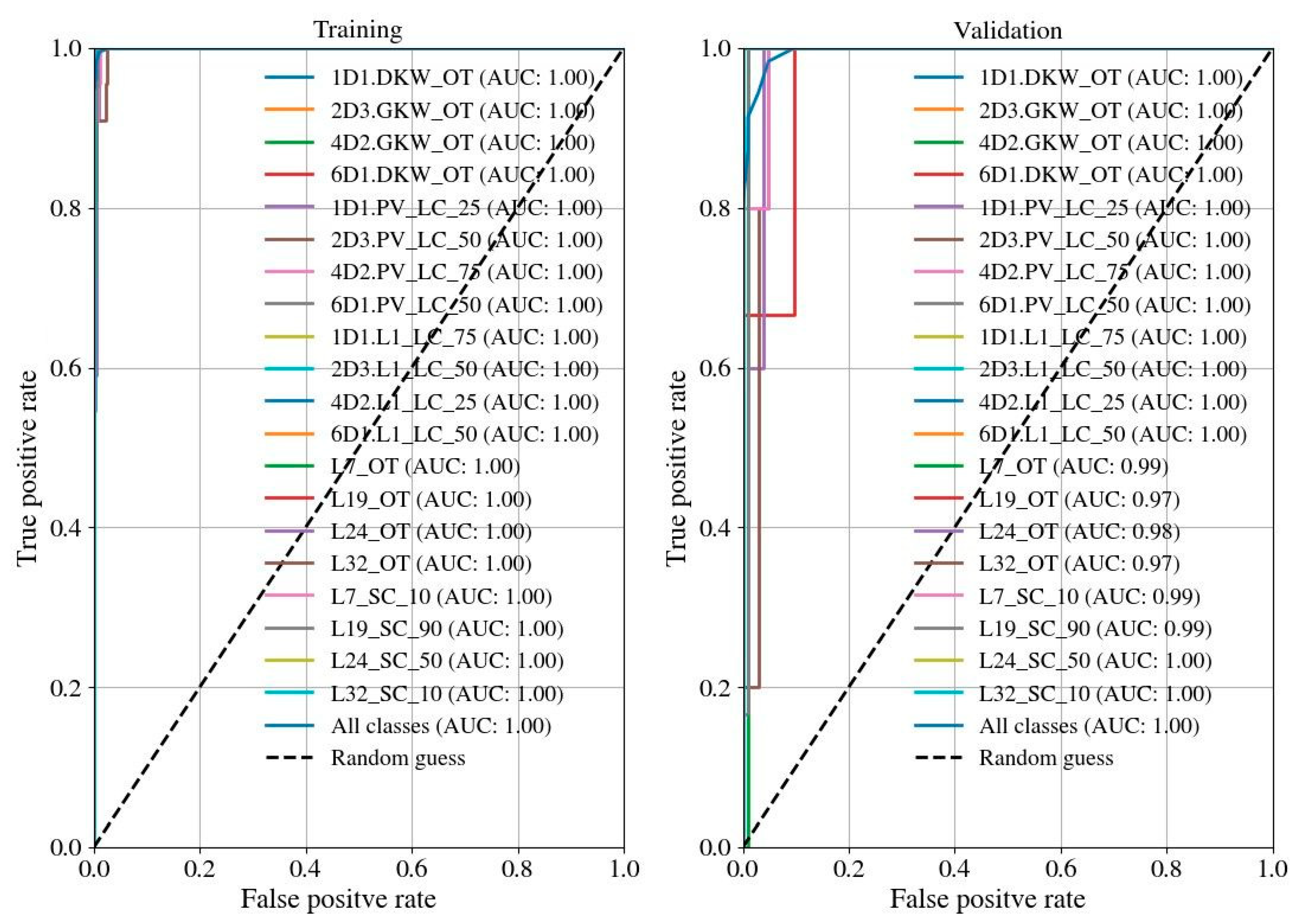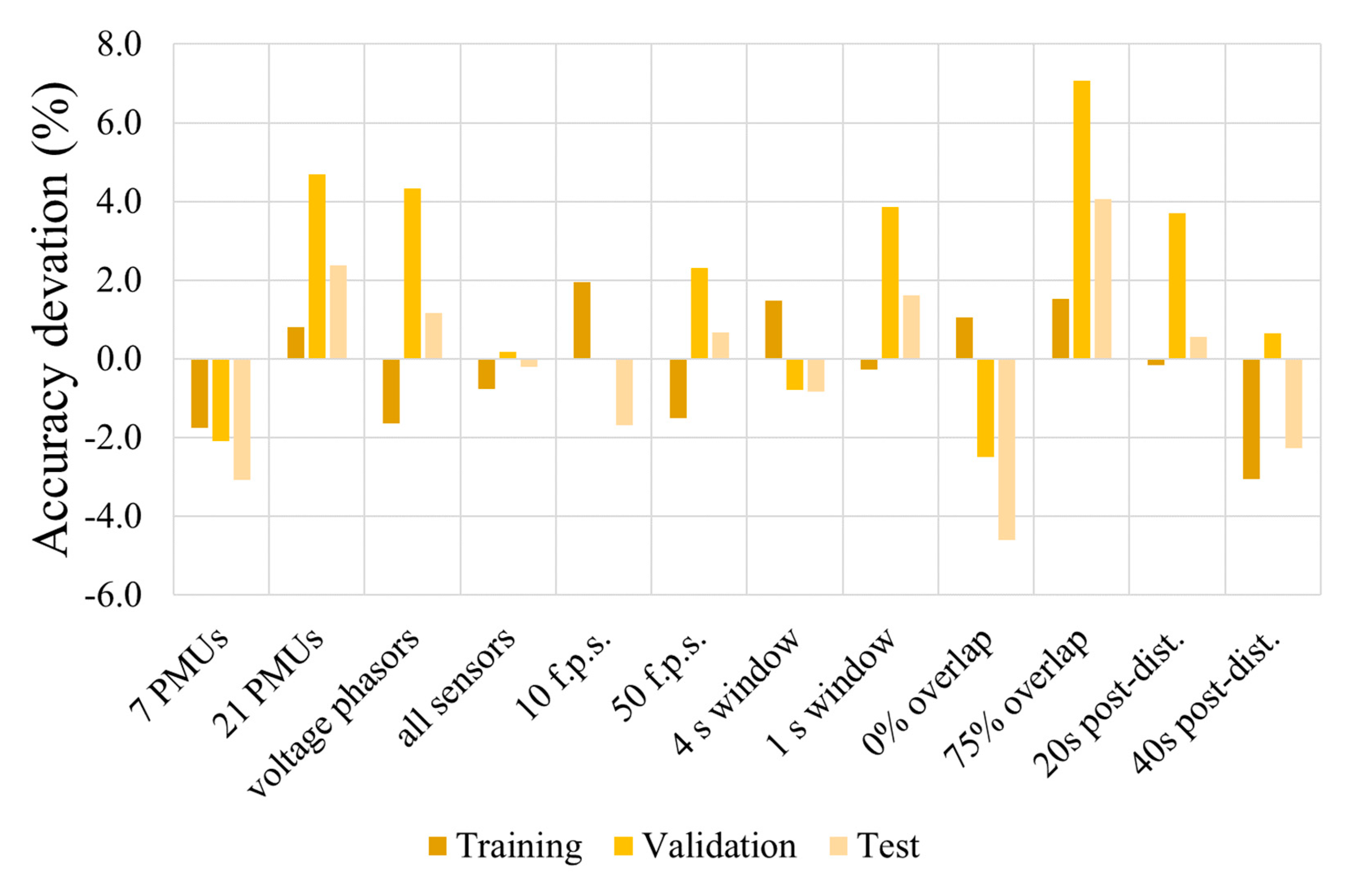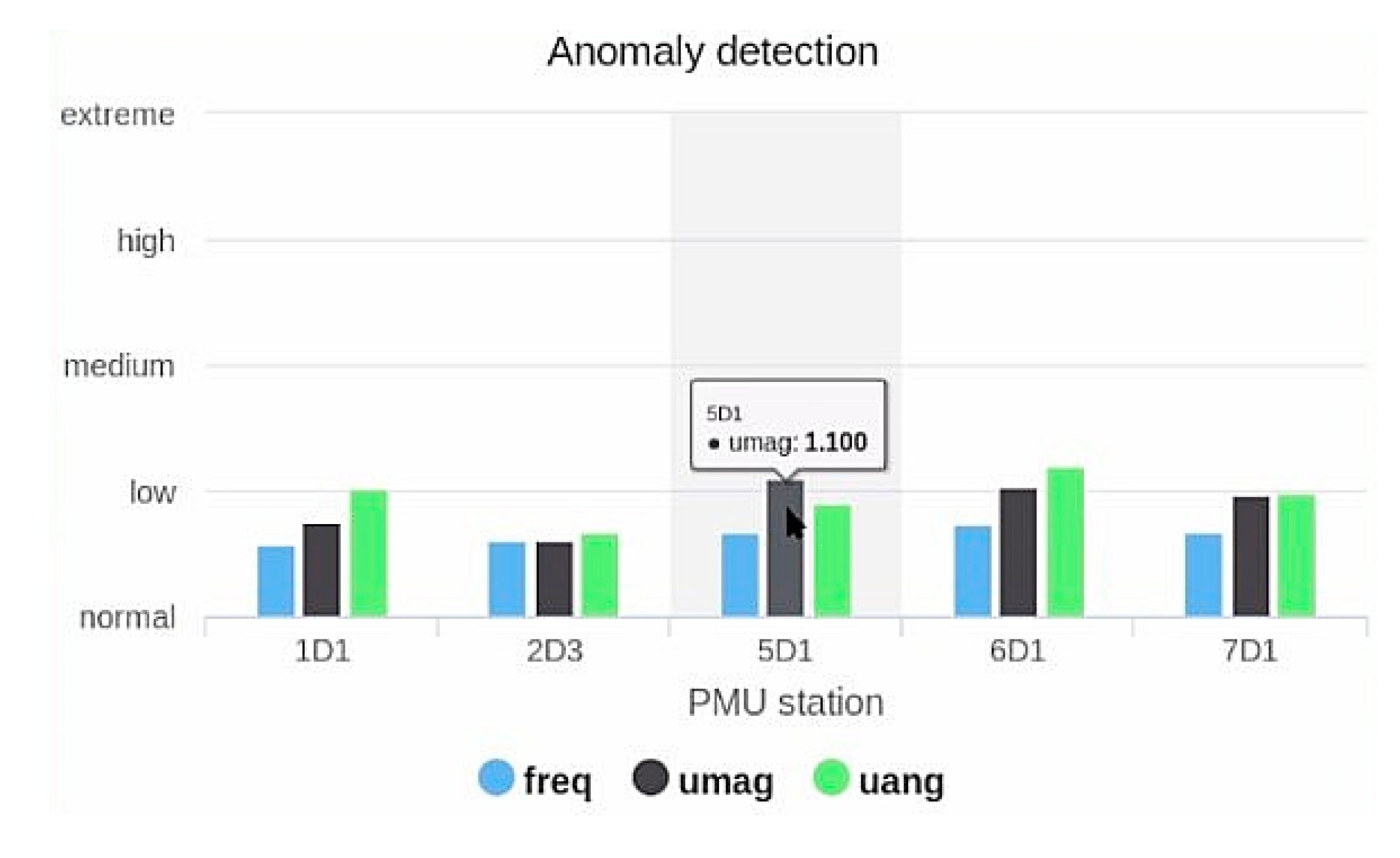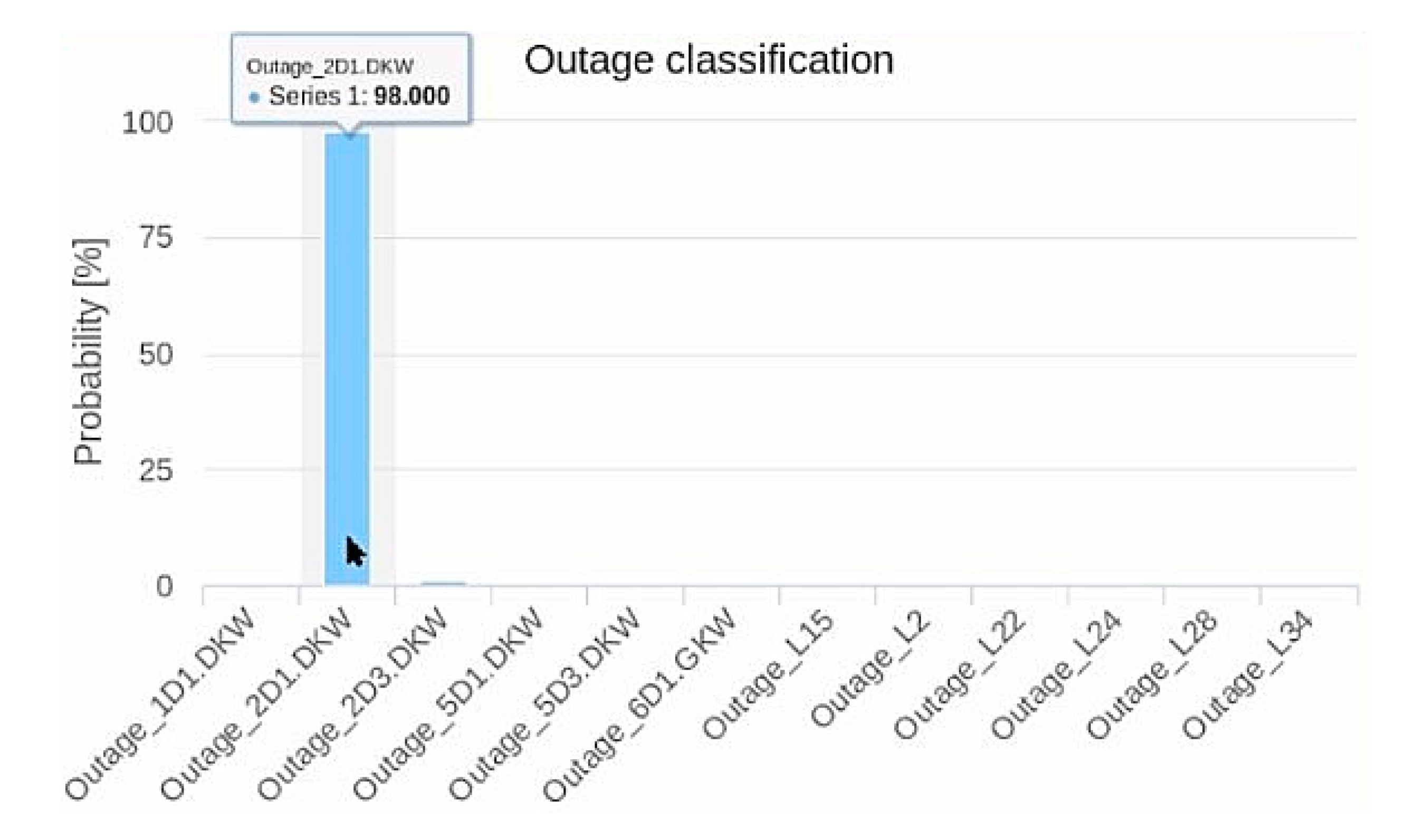3.1. Framework Architecture and Analysis Modules
In this study, a novel framework for analyzing historical and online synchrophasor measurements is presented in order to detect and classify grid disturbances and to activate suitable countermeasures. In contrast to existing approaches (see
Section 2.3), additional knowledge from historical measurement records can be integrated in order to increase the recognition capabilities and the classification accuracies of the online analysis modules. This framework combines different offline and online synchrophasor applications to enable an efficient analysis and decision-making based on simulated and measured critical events. The proposed analysis modules comprise of a
spatiotemporal data compression module,
disturbance extraction module,
disturbance detection module and
disturbance classification module.
The
spatiotemporal data compression module eliminates redundant information for an efficient processing and analysis of large historical phasor measurement records. Due to the high reporting rates (typically between 10 and 50 frames per second [
18]) and the large number of installed PMU sensors especially in large power grids, high data volumes and transmission rates occur when collecting synchrophasor data in control centers. With the use of statistical methods, the storage demand in modern control centers can be drastically reduced. This enables a long-term archiving of phasor data as well as an efficient post-mortem analysis of large datasets. A detailed description of the
spatiotemporal data compression module is given in
Section 3.2.
The
disturbance extraction module analyzes compressed synchrophasor data records to extract potential critical events and to enhance the training database of the
disturbance classification module. For this purpose, an intelligent analysis procedure is proposed to automatically explore historical measurement records and to discover potential interesting events that were not detected with existing grid monitoring tools. These events mainly include disturbances like malfunctions, outages, oscillations, faults or other unusual deviations from regular grid operation. It is to be expected, that only a small part of the measurement records contain relevant events. Additionally, no prior knowledge is available, which further complicates the recognition task. Extracted events or disturbances can be processed further, e.g., for root-cause event analysis, the assessment of grid assets and the enhancement of training data or subsequent signal analysis algorithms (e.g., for the disturbance detection module and disturbance classification module in
Section 3.4 and
Section 3.5).
The disturbance detection module detects deviations from steady conditions by computing an anomaly score for each PMU measurement channel. In contrast to the previous application modules, this is done online using a sliding window-based approach. Generally, there is a vast number of possible events or disturbances, which lead to deviations from steady state conditions including outages, short circuits / faults, oscillations or malfunctions. The automated recognition of these events is a basic prerequisite to prevent undesired or unstable system states and to initiate suitable countermeasures. In contrast to the disturbance classification module, an exact identification of the disturbance type or the location of the disturbance origin is not performed. Instead, the goal of the disturbance detection module is to recognize possible disturbances, if only undisturbed system conditions are known. Therefore, the disturbance detection module can act as a trigger for subsequent process analysis or can enhance the training data base.
In case of high anomaly scores, the
disturbance classification module estimates the disturbance type and location of the transient event by computing the corresponding probabilities of occurrence. Similar to the
disturbance detection module, this is done online by analyzing the current phasor data stream. Compared to traditional SCADA or protection systems, a wide range of possible disturbances can be detected within short time spans (< 1 s) including outages from generators, lines, or renewable energy sources as well as short circuits or load trips. Precise information about the origin and type of the disturbance as well as additional time and frequency analysis information (e.g., oscillation modes, frequency drops) enable the initialization of precise countermeasures (e.g., curative actions) to restore a stable system state. These actions can be precomputed for different disturbances and updated with each new steady state condition. Today’s DSA systems provide sufficient computation options to simulate different contingencies and to select and assess suitable countermeasures [
13]. Further descriptions are given in
Section 3.6.
For a better understanding,
Figure 2 shows the simplified workflow and interaction between the different synchrophasor based online and offline analysis modules. The phasor data concentrator collects the phasor measurements and continuously updates a database. At the same time, the online data stream is forwarded to the online analysis modules. The offline analysis modules can be activated periodically to process a certain amount of historical measurement records. The measurement and analysis results can be visualized with a web-based user interface (see
Section 5) and can be transferred to subsequent EMS applications.
3.2. Spatiotemporal Synchrophasor Data Compression
The idea of data compression is to transform the original input measurements into a small subset of coefficients with minimum information loss. The smaller this subset is compared to the size of the uncompressed signal, the higher is the compression rate. The applied signal transformation aims to eliminate all redundant information and can be inverted to reconstruct the original signals with a certain error (reconstruction error). In contrast to existing single-step approaches, the
spatiotemporal data compression module combines two compression stages to identify and eliminate redundant synchrophasor data in space (e.g., by PMU sensors with close proximity) and time (e.g., by low signal variations over long time spans)–see
Figure 3. This enables high compression rates in presence of transient events and preserves low reconstruction errors. The compression rate
is calculated according to (1) given the cardinality of the normalized input signal
divided by the cardinality of the compressed signal
. The transformation coefficients
must also be taken into account, because they are required to reconstruct the original signals.
The reconstruction error
is based on the L2-norm (squared Euclidean distance) between the original signal and the reconstructed signal
–see (2).
Minimizing this error ensures a close approximation of the original measurement matrix.
For the spatial compression stage, different dimension reduction techniques can be used including principle component analysis (PCA), independent component analysis and non-negative matrix factorization. In case of the temporal compression, time-frequency transformations are suitable like discrete wavelet transform (DWT), discrete cosine transform or fast Fourier transform. Based on preliminary work [
44], PCA and DWT are used as best combination to achieve low reconstruction errors and high compression rates. In the spatial compression stage, PCA is applied on the normalized measurement matrix, which creates a set of “virtual” PMU sensors depending on the number of chosen principle components. This ensures that only non-redundant information (highest signal variances) are captured by the first principle components. In this step, the temporal dimension (number of time steps) remains the same. In the second compression stage, DWT transforms each “virtual” sensor signal into the frequency domain. In case of multiple decomposition levels, this transform is applied recursively to generate the approximation and detailed coefficients. A compression is achieved by setting some detailed coefficients to zero depending on a predefined, global threshold value. PCA and DWT are both linear signal transform techniques. The PCA and the DWT parameters can be reused in the spatial and the temporal inverse processes to reconstruct the “virtual” sensor signals as well as the input measurement matrix–see
Table 1. This procedure is applied on each PMU channel separately assuring optimal compression rates and reconstruction errors. A detailed description of the methodology as well as a comparison between the different compression techniques is given in [
44].
3.3. Disturbance Extraction (Post-Mortem Analysis)
The
disturbance extraction module detects a predefined number of possible grid disturbances by analyzing historical records of a single phasor measurement signal (e.g., frequency). The lack of positive examples (non-outliers) and negative examples (outliers) as well as the high diversity of outlier types makes an exact prediction very difficult. To minimize the variance of the model predictions, different feature extraction, dimension reduction and outlier score estimation techniques are combined within an ensemble-based approach. Each outlier detection algorithm uses different metrics for the outlier scores, which makes a direct comparison difficult. Therefore, a rank transformation aggregates the outlier scores of the base detectors, such that high rank values correspond to low outlier scores and vice versa. In a final clustering stage, only the samples with the lowest total rank values are chosen. The goal of the clustering algorithm is to group similar disturbance patterns into meaningful classes. Therefore, a similarity matrix is computed using time-warp edit distance (TWED) [
45]. The resulting dissimilarity matrix is passed to a hierarchical density based clustering algorithm (HDBSCAN) [
46] to identify the cluster groups without prior knowledge about the number of cluster groups. For the
disturbance extraction module, three outlier detection algorithms are used including local outlier factors (LOF) [
47], correlation outlier probabilities (COP) [
48] and single-linkage based outlier detection (SiLiOd) [
49]. These algorithms compute an outlier score to measure the deviation to the normal or majority signal behavior. The main principles of the three algorithms for the outlier scores are given in
Table 2.
As mentioned earlier, the ensemble-based
disturbance extraction module uses multiple base detectors to compute outlier scores and extract potential unusual or abnormal records. The base detectors differentiate with respect to the used dimension reduction technique (PCA or Isomap) and the outlier detection method (LOF, COP or SiLiOd). This leads to a total number of six base detectors within the
disturbance extraction module. Each base detector calculates in total 13 features including statistical and information-based metrics in time-domain as well as energy based features from Stockwell transform coefficients and discrete wavelet transform coefficients. This comprehensive feature representation allows to capture various signal traits in different disturbed situations like abrupt signal changes, oscillations, or other dynamic variations. A short overview of the different base detectors is given in
Figure 4. Further literature can be found in [
49,
50].
3.4. Disturbance Detection
Anomaly detection or novelty detection is an active research area in machine learning to automatically detect abnormal signal behavior or signal patterns that deviate strongly from the expected or majority behavior. This is different from the outlier detection (see
Section 3.3), in which the negative examples in the training dataset are unlabeled or unknown. Different techniques are proposed in literature including classification based approaches (e.g., one-class support vector machine), clustering based approaches (e.g., density-based clustering) or subspace-based approaches (e.g., principle component analysis) and have a high resemblance with outlier detection methods. Further literature can be found in [
51,
52]. Compared to other approaches, the z-score based
disturbance detection module computes anomaly scores instead of a binary decision. This is done by deriving features in the time- and frequency-domain and by applying a Z-transformation considering a fixed amount of historical feature values. The resulting z-scores are computed for each PMU measurement channel separately assuming a Gaussian feature distribution within the normal grid operation. The basic workflow is given in
Figure 5.
The input matrix
consists of the
last measurement samples
and are normalized into the range
. Within the feature extraction step, a feature vector
is created for each sample using signal analysis techniques in the time- und frequency-domain–see (3) and (4).
After the feature extraction phase, z-scores
are computed for each feature using the actual feature value
, the mean and the standard deviation of all past
features of the current measurement channel
. The z-score vector
contains the z-scores from all feature values–see (5) and (6).
The final z-score for a given PMU measurement channel can be derived from the maximum value within the z-score vector. A short overview of the
features is given in
Table 3. As a very rough approach, an anomaly level can be estimated depending on these z-score values using the overview in
Table 4.
3.5. Disturbance Classification
From machine learning perspective, the PMU based identification and localization of grid disturbances can be solved with a time-series classification (TSC) system. A general classification system comprises of the following sub-modules:
preprocessing: normalize the input data into a suitable data range,
feature extraction: extract relevant features to distinguish between the given classes,
classification: compute affiliation values (e.g., probabilities) for each class using the features and
decision-making: final class assignment of the current observation based on the maximum affiliation value.
In particular, the feature extraction from multidimensional sequential data is a challenging task that takes into account the spatiotemporal relationships within the input data. Current TSC approaches include sequence-based, similarity-based (e.g., dynamic time warping), feature-based (e.g., symbolic piecewise aggregation) and model-based techniques (e.g., hidden Markov models, neural networks)–see [
53,
54]. Especially recurrent neural networks like long short-term memories (LSTM) or gated recurrent units (GRU) provide state-of-the-art results when dealing with high-dimensional sequential inputs like speech, text or video data–see [
55,
56,
57].
Compared to existing approaches, see
Section 2.3, the
disturbance classification module uses a single prediction model to simultaneously identify and locate grid disturbances from phasor measurements. Dynamic simulations are used to create the training data for a predefined set of contingencies. The input matrix for the classification algorithm comprises of
normalized measurements from multiple PMU sensors of the grid (no full observability required) over a fixed time span
–see (7). The target values of the classifier are the disturbance location
and the disturbance type
, which are summarized within the class label
–see (8).
First investigations of a simultaneous disturbance identification and localization were performed in [
58] by comparing five different classification approaches. From these results and additional research [
59], recurrent neural networks were rated as very suitable for the online classification of grid disturbances regarding the classification accuracy and prediction time. Recurrent neural networks like LSTMs or GRUs can capture autoregressive, non-linear dependencies and time-varying patterns in high-dimensional sequential data by utilizing flexible gating mechanisms within the LSTM or GRU cells. Within this study, GRUs were preferred over LSTMs to increase the robustness and to minimize overfitting problems. The principle workflow of the GRU-based disturbance classification approach is shown in
Figure 6.
In the feature extraction step, a hidden state matrix
is computed by a single GRU layer with
dimensions given the normalized measurement matrix
and the learned parameters
. Afterwards, a feature vector
of dimension
is generated from the high-dimensional hidden state matrix using an embedding function
with
. The general equations are given in (9) and (10).
The goal of the embedding function is to capture the necessary information from the hidden state matrix to differentiate between the classes. According to (11) and (12), the classifier
is based on a standard softmax regression to compute the class probability vector
with the parameters
over all
classes.
The final class assignment
is based on the maximum probability value estimated by the classifier. The parameters of the feature extraction
, embedding
and classifier
are learned jointly via backpropagation using the cross-entropy loss formulation given in (13).
The GRU layer in the feature extraction step contains the most expensive operations in the
disturbance classification module. For each time step
, the GRU computes a hidden state vector
using the actual input vector
and the hidden state vector from the previous time step
. This is done sequentially over all
time steps to compute the hidden state matrix
. The weights and biases of the GRU
are shared among all time steps. The principle workflow is shown in
Figure 7.
Inside a GRU, the input vector and the last hidden state vector are used to compute the output vectors of the update gate
and the reset gate
. From that, a candidate hidden state vector
is estimated, which represents the actual information gained by the GRU. In the last step, the new hidden state vector
is computed depending on the output of the update gate vector, which decides whether to keep the old information (
) or to forget them and to use the new information (
). These gating mechanisms allow a very flexible control over the learned representations and accounts for the vanishing gradient problem when applying backpropagation over time (BPTT). The basic formulations for the gate calculations are given in (14) to (17).
Despite of the gating mechanisms, the information cannot be maintained over long time periods. As the number of time steps increases, some information might be lost or overwritten such that the final hidden state vector
does not contain all necessary information to classify the time series. Hence, different embedding functions are proposed to create a representative feature vector from the full hidden state matrix including feedforward neural networks as well as parametric and non-parametric attention models–see
Figure 8.
Feedforward neural network-based embedding: A very straightforward solution includes a single layer feedforward neural network with sigmoid activation function applied on the vectorized hidden state matrix. Depending on the number of time steps
and hidden dimensions
, this can result in a large weight matrix
. The equation is given in (18).
Parametric and non-parametric attention model based embedding: A more efficient approach utilizes attention models to compute a weighted sum of the hidden state vectors–see (19). According to (20), these attention weights
are computed for each time step using a softmax normalization on the score values
. In this case, the feature dimension equals the hidden dimension
, such that no additional dimension reduction is performed within the embedding function.
A score value indicates the importance of the current hidden state, such that high score values lead to high attention weights and vice versa. Within the parametric attention model (derived from [
60]), a small feedforward neural network with tangent hyperbolic activation function computes the score values–see (21). The network parameters can be shared over time steps (global parametric attention model) or calculated for each time step separately (local parametric attention model).
The non-parametric attention model uses dot-product (22) or cosine similarity (23) to calculate the score values. For this, the actual hidden state
is compared with the last hidden state
for each time step.
